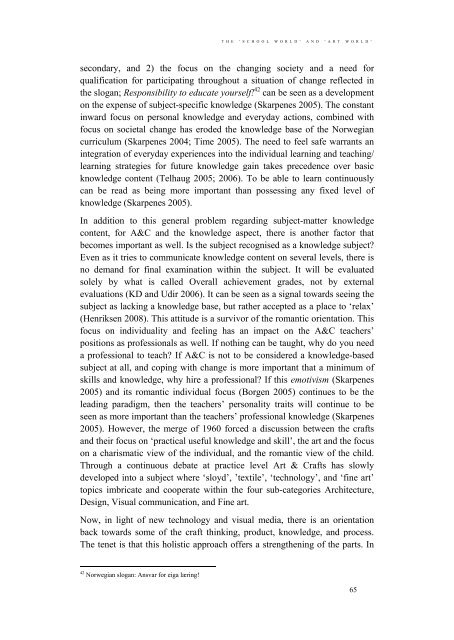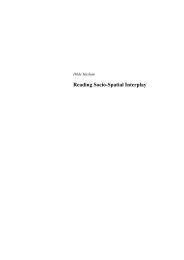CON ⢠TEXT - Arkitektur- og designhøgskolen i Oslo - AHO
CON ⢠TEXT - Arkitektur- og designhøgskolen i Oslo - AHO
CON ⢠TEXT - Arkitektur- og designhøgskolen i Oslo - AHO
- No tags were found...
You also want an ePaper? Increase the reach of your titles
YUMPU automatically turns print PDFs into web optimized ePapers that Google loves.
T H E ’ S C H O O L W O R L D ’ A N D ’ A R T W O R L D ’secondary, and 2) the focus on the changing society and a need forqualification for participating throughout a situation of change reflected inthe sl<strong>og</strong>an; Responsibility to educate yourself! 42 can be seen as a developmenton the expense of subject-specific knowledge (Skarpenes 2005). The constantinward focus on personal knowledge and everyday actions, combined withfocus on societal change has eroded the knowledge base of the Norwegiancurriculum (Skarpenes 2004; Time 2005). The need to feel safe warrants anintegration of everyday experiences into the individual learning and teaching/learning strategies for future knowledge gain takes precedence over basicknowledge content (Telhaug 2005; 2006). To be able to learn continuouslycan be read as being more important than possessing any fixed level ofknowledge (Skarpenes 2005).In addition to this general problem regarding subject-matter knowledgecontent, for A&C and the knowledge aspect, there is another factor thatbecomes important as well. Is the subject rec<strong>og</strong>nised as a knowledge subject?Even as it tries to communicate knowledge content on several levels, there isno demand for final examination within the subject. It will be evaluatedsolely by what is called Overall achievement grades, not by externalevaluations (KD and Udir 2006). It can be seen as a signal towards seeing thesubject as lacking a knowledge base, but rather accepted as a place to ‘relax’(Henriksen 2008). This attitude is a survivor of the romantic orientation. Thisfocus on individuality and feeling has an impact on the A&C teachers’positions as professionals as well. If nothing can be taught, why do you needa professional to teach? If A&C is not to be considered a knowledge-basedsubject at all, and coping with change is more important that a minimum ofskills and knowledge, why hire a professional? If this emotivism (Skarpenes2005) and its romantic individual focus (Borgen 2005) continues to be theleading paradigm, then the teachers’ personality traits will continue to beseen as more important than the teachers’ professional knowledge (Skarpenes2005). However, the merge of 1960 forced a discussion between the craftsand their focus on ‘practical useful knowledge and skill’, the art and the focuson a charismatic view of the individual, and the romantic view of the child.Through a continuous debate at practice level Art & Crafts has slowlydeveloped into a subject where ‘sloyd’, ’textile’, ‘technol<strong>og</strong>y’, and ‘fine art’topics imbricate and cooperate within the four sub-categories Architecture,Design, Visual communication, and Fine art.Now, in light of new technol<strong>og</strong>y and visual media, there is an orientationback towards some of the craft thinking, product, knowledge, and process.The tenet is that this holistic approach offers a strengthening of the parts. In42 Norwegian sl<strong>og</strong>an: Ansvar for eiga læring!65
















